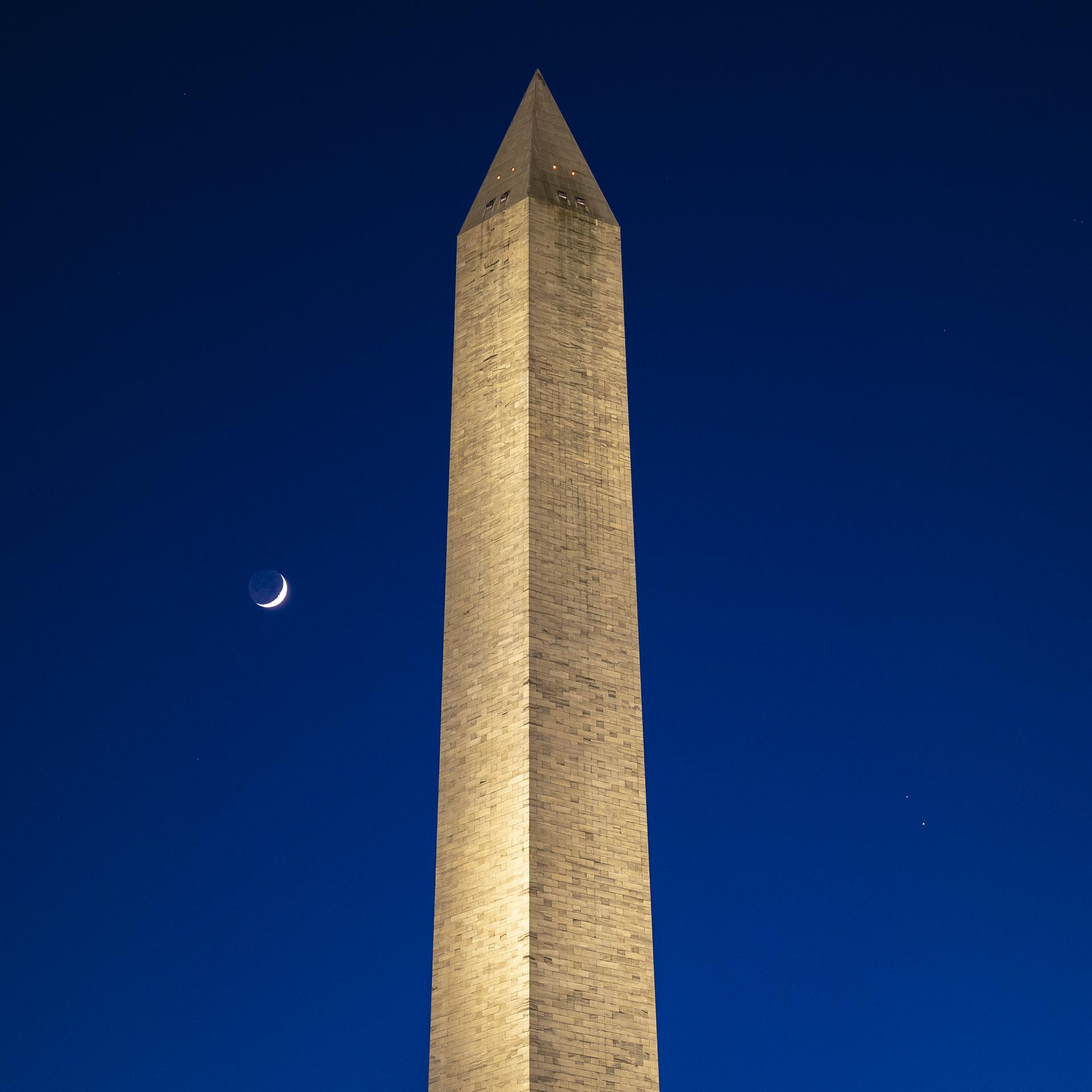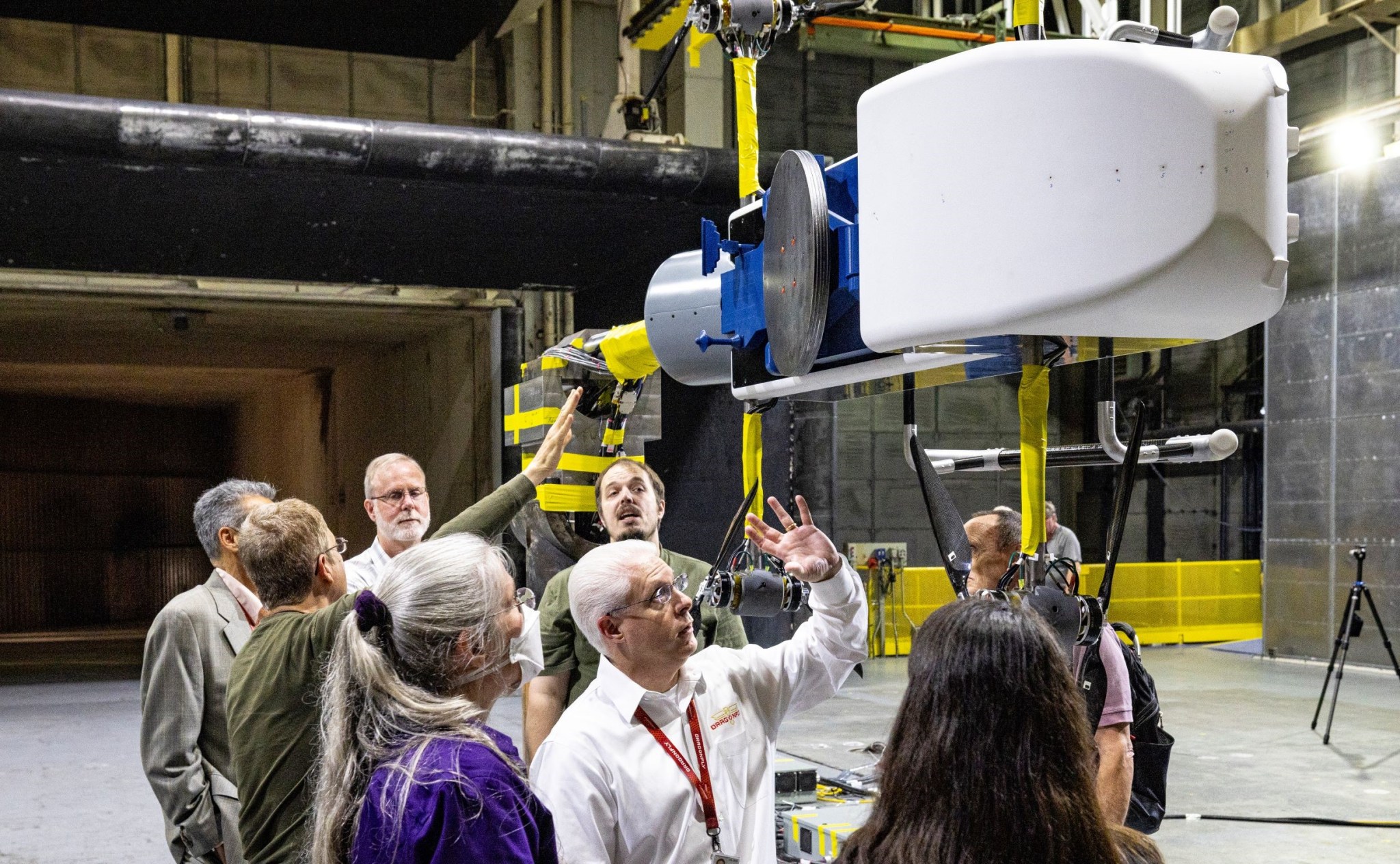NASA, ESA, A. Simon (Goddard Space Flight Center), M.H. Wong (University of California, Berkeley), and the OPAL Team NASA’s Hubble Space Telescope captured this image of Saturn and its colossal rings on July 4, 2020, during summer in the gas giant’s northern hemisphere. Two of Saturn’s icy moons are also clearly visible: Mimas at right, and Enceladus at bottom. The light reddish haze over the northern hemisphere seen in this color composite could be due to heating from increased sunlight, which could either change the atmospheric circulation or remove ices…
Read MoreTag: Saturn
A Moonlit Trio
NASA/Bill Ingalls The Moon (left), Saturn, and Jupiter (lower right; Saturn is above and to the left of Jupiter) were seen in the sky above the Washington Memorial on Dec. 17, 2020. At the time, Saturn and Jupiter were nearing each other in the sky, culminating in a “great conjunction” on Dec. 21, where they appeared a tenth of a degree apart. Great conjunctions between Jupiter and Saturn happen every 20 years, making the planets appear to be close to one another. This closeness occurs because Jupiter orbits the Sun…
Read MoreSaturn’s ‘Death Star’ moon Mimas may have an ocean scientists never believed could exist
Astronomers have discovered that a tiny moon of Saturn, named Mimas, may harbor a hidden liquid ocean beneath its thick icy shell and may thus have the conditions for habitability. This shocking finding radically changes the definition of what an ocean moon can be, and could ultimately redefine our search for alien life on moons in the solar system. That’s because, at first appearance, Mimas — nicknamed the ‘Death Star‘ because a large crater means it resembles the Empire’s space station in Star Wars — doesn’t look like the kind…
Read MoreFloating ‘magic islands’ on Saturn’s moon Titan may be honeycomb-shaped snow
The floating “magic islands” of Saturn’s largest moon, Titan, may finally have a scientific explanation. Scientists believe they’re clumps of glacier-like snow shaped like honeycomb. The so-called islands were first spotted in 2014 by the Cassini-Huygens spacecraft as it peered through the orange haze surrounding Titan, which is a moon that’s bigger than the planet Mercury. Appearing as shifting bright spots on the Saturnian moon above lakes of liquid methane and ethane, the islands left scientists struggling for an explanation. No one could figure out how these ephemeral blocks could…
Read MoreFinding life on Saturn’s moon Enceladus might be easier than we thought
New research suggests there are locations on the surface of Saturn’s moon, Enceladus, where spacecraft could land to scoop up pristine traces of the key ingredients for life. It’s believed that these biosignatures come from subsurface oceans within the world’s icy shell. Enceladus has long been known to harbor organic molecules — compounds comprised of carbon, oxygen and nitrogen — in its subsurface oceans. Before it plunged to the surface of Saturn in 2017, the Cassini spacecraft flew through plumes of material erupting through fissures in the surface of Enceladus,…
Read MoreNuclear-powered Dragonfly mission to Saturn moon Titan delayed until 2028, NASA says
NASA has set a provisional launch date of July 2028 for its Dragonfly mission, meant to explore Saturn’s largest moon Titan, with budgetary uncertainty cited as the reason for the project’s one-year delay. The Dragonfly team can now move forward with the next stage of development — Phase C — for the car-sized, nuclear-powered rotorcraft drone that will fly above and land on the sands of Titan, a world planetary scientists believe is rich in organic molecules. “The Dragonfly team has successfully overcome a number of technical and programmatic challenges…
Read MoreEvidence of alien life may exist in the fractures of icy moons around Jupiter and Saturn
Scientists are investigating specific geological features on the largest moons of both Jupiter and Saturn that could be ideal spots for the emergence of life elsewhere in the solar system. The team, led by researchers from the University of Hawaii at Mānoa, looked at what are called “strike-slip faults” on the Jovian moon, Ganymede — the solar system’s largest moon, bigger even than the planet Mercury — and Saturn’s moon, Titan. Faults like these happen when fault walls move past each other horizontally, either to the left or the right,…
Read MoreNASA wants to fly this nuclear Dragonfly drone on Saturn’s moon Titan. Watch its wind tunnel test (video)
Testing is now underway on NASA’s Dragonfly rotorcraft, a nuclear-powered, car-sized aerial drone that will look for potential precursors to life on Saturn’s moon, Titan. But before Dragonfly can take to the sky, NASA has to make sure it can withstand the moon’s unique environment. Dragonfly’s main goal is to study the complex chemistry on Titan that may give insights into the origins of life in our solar system. Equipped with cameras, sensors, and samplers, this vehicle will investigate areas of Titan known to contain organic materials, especially those regions…
Read MoreNASA’s Dragonfly Tunnel Visions
5 min read NASA’s Dragonfly Tunnel Visions Dragonfly Team Utilizes Unique NASA Facilities to Shape Its Innovative Titan-bound Rotorcraft Dragonfly team members review the half-scale lander model after it underwent wind tunnel testing at NASA Langley Research Center in Hampton, Virginia. Pictured are (from left) Art Azarbarzin, Juan Cruz, Wayne Dellinger, Zibi Turtle, Chuck Hebert, Ken Hibbard, Bernadine Juliano and Bruce Owens. Johns Hopkins APL/Ed Whitman With its dense atmosphere and low gravity, Saturn’s moon Titan is a great place to fly. But well before NASA’s Dragonfly rotorcraft lander soars…
Read MoreA giant moon collision may have given rise to Saturn’s iconic rings, study suggests
A collision between two ancient icy moons that may have once orbited Saturn could have given rise to the planet’s iconic ring system, a new study reveals. Saturn is probably the most eye-catching planet in the solar system, but it may also be one of the most mind-boggling. Surrounded by a series of seven concentric rings and orbited by an army of 245 moons, the gas giant, second in size only to Jupiter, has puzzled astronomers for centuries. A new study may have found an answer to one of Saturn’s…
Read More

